GIGABYTE BRIX Gaming BXi5G-760 mini-PC Review
by Ganesh T S on September 15, 2014 2:30 PM ESTPerformance Metrics - II
In this section, we mainly look at benchmark modes in programs used on a day-to-day basis, i.e, application performance and not synthetic workloads.
x264 Benchmark
First off, we have some video encoding benchmarks courtesy of x264 HD Benchmark v5.0. This is simply a test of CPU performance. As expected, the Core i5-4200H can't match up to the i7 parts in the other mini PCs that we compare against.
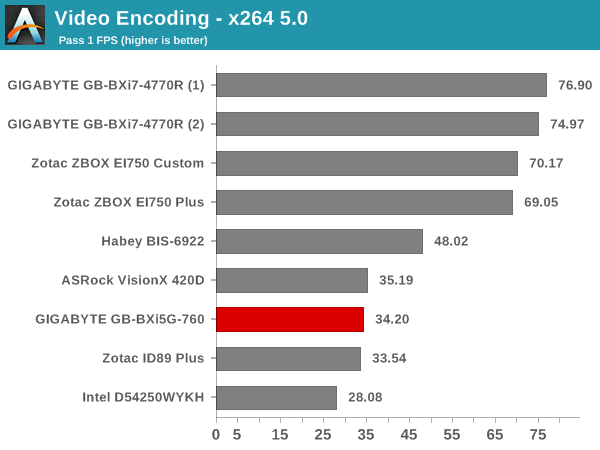
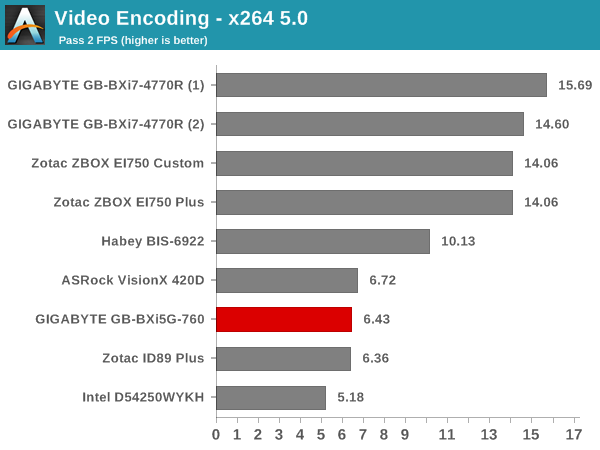
7-Zip
7-Zip is a very effective and efficient compression program, often beating out OpenCL accelerated commercial programs in benchmarks even while using just the CPU power. 7-Zip has a benchmarking program that provides tons of details regarding the underlying CPU's efficiency. In this subsection, we are interested in the compression and decompression MIPS ratings when utilizing all the available threads.
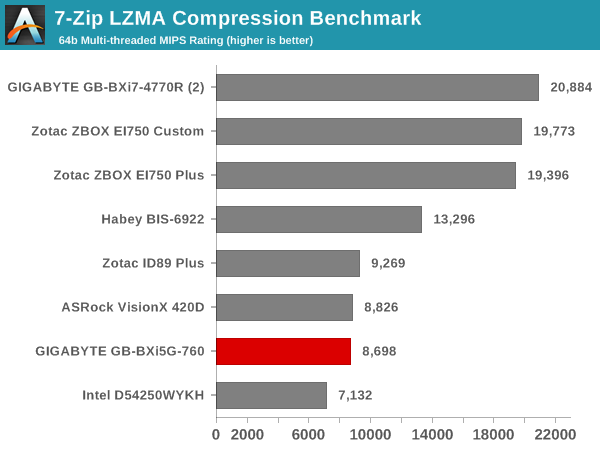
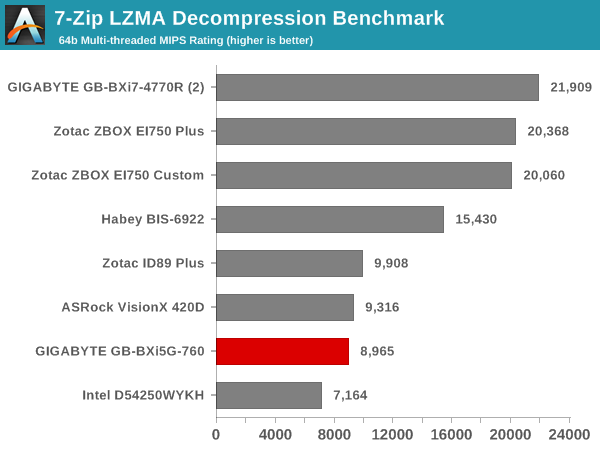
TrueCrypt
As businesses (and even home consumers) become more security conscious, the importance of encryption can't be overstated. CPUs supporting the AES-NI instruction for accelerating the encryption and decryption processes have, till now, been the higher end SKUs. However, with Bay Trail, even the lowly Atom series has gained support for AES-NI. The Core i5-4200H in the BXi5G-760 does have AES-NI support. TrueCrypt, a popular open-source disk encryption program can take advantage of the AES-NI capabilities. The TrueCrypt internal benchmark provides some interesting cryptography-related numbers to ponder. In the graph below, we can get an idea of how fast a TrueCrypt volume would behave in the GIGABYTE BXi5G-760 and how it would compare with other select PCs. This is a purely CPU feature / clock speed based test.

Agisoft Photoscan
Agisoft PhotoScan is a commercial program that converts 2D images into 3D point maps, meshes and textures. The program designers sent us a command line version in order to evaluate the efficiency of various systems that go under our review scanner. The command line version has two benchmark modes, one using the CPU and the other using both the CPU and GPU (via OpenCL). The benchmark takes around 50 photographs and does four stages of computation:
- Stage 1: Align Photographs
- Stage 2: Build Point Cloud (capable of OpenCL acceleration)
- Stage 3: Build Mesh
- Stage 4: Build Textures
We record the time taken for each stage. Since various elements of the software are single threaded, others multithreaded, and some use GPUs, it is interesting to record the effects of CPU generations, speeds, number of cores, DRAM parameters and the GPU using this software.

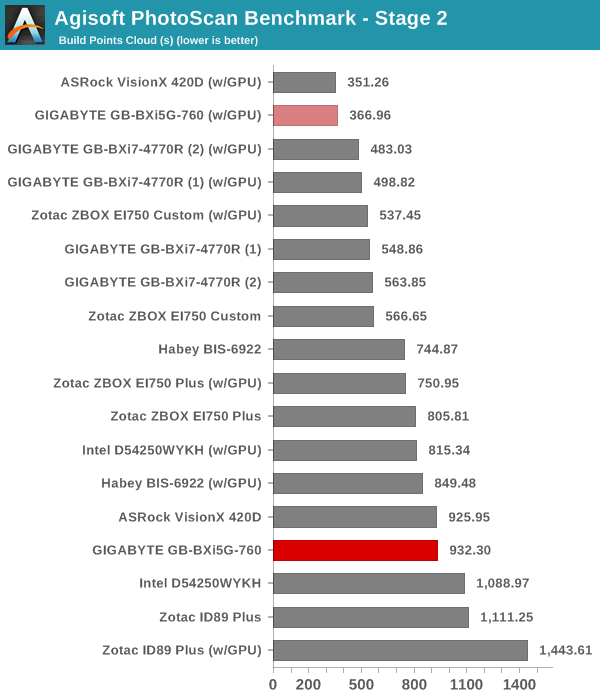
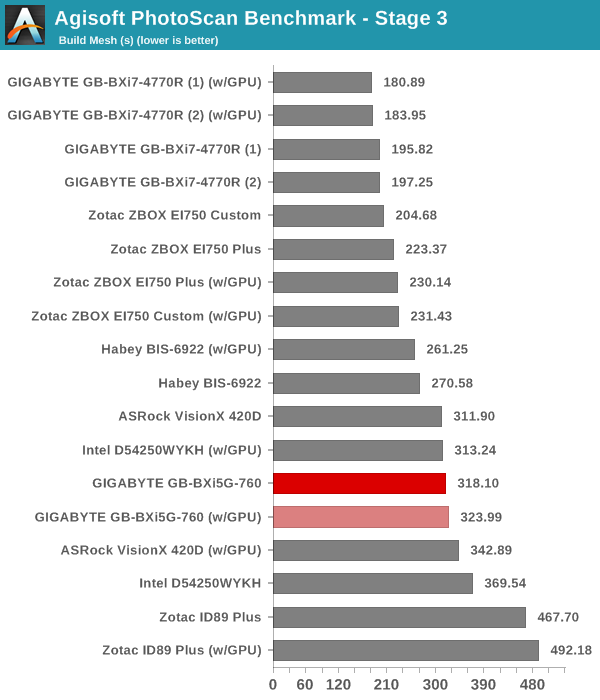
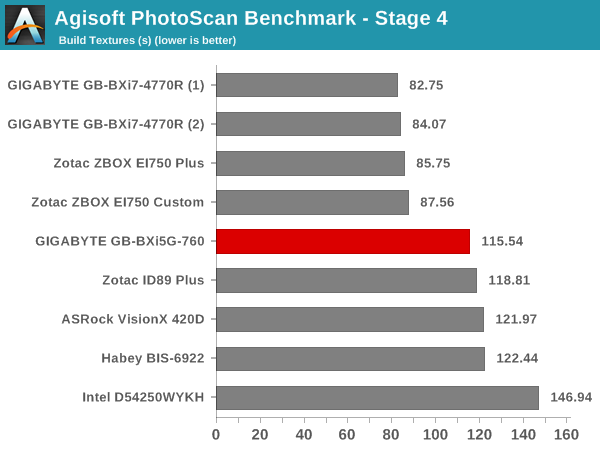
Dolphin Emulator
Wrapping up our application benchmark numbers is the Dolphin Emulator benchmark mode results. This is again a test of the CPU capabilities, and the Core i5-4200H comes up short against the Core i7-4770R











35 Comments
View All Comments
daddacool - Tuesday, September 16, 2014 - link
The sooner Gigabyte bites the bullet and does a gaming brix with watercooling the better. Until they do that, the thermal constraints make it a little pointless IMHOhojnikb - Tuesday, September 16, 2014 - link
where the hell would they put watercooling ?dj_aris - Tuesday, September 16, 2014 - link
Just invest $50 more on R&Ding better cooling on a $1000 pc, Gigabyte. Bigger fans? Bigger chassis? A tiny water cooling module? How awesome would that be.DiseasedPidgeon - Tuesday, September 16, 2014 - link
The reason they've made this small is for a living room unit. I prefer the solution provided by the G-Pack. http://piixl.comHaravikk - Monday, October 6, 2014 - link
Another waste of money from the Brix line; anything in this form factor that requires cooling is a dead end on thermal and acoustic performance. But the really weird thing is that it might not be so bad if they'd just build their own cooling system; put the CPU at the top facing down, and the GPU at the bottom facing up, sandwiching a nice big heat-sink with a built-in blower fan and you might just improve things, but two tiny fans shoved into a position they can't possibly cool properly from is not the answer.It's silly really, as machines only slightly bigger are far more compelling. The Alienware Alpha for example is still extremely small, but ought to have similar, or even better, performance for a lot less money.